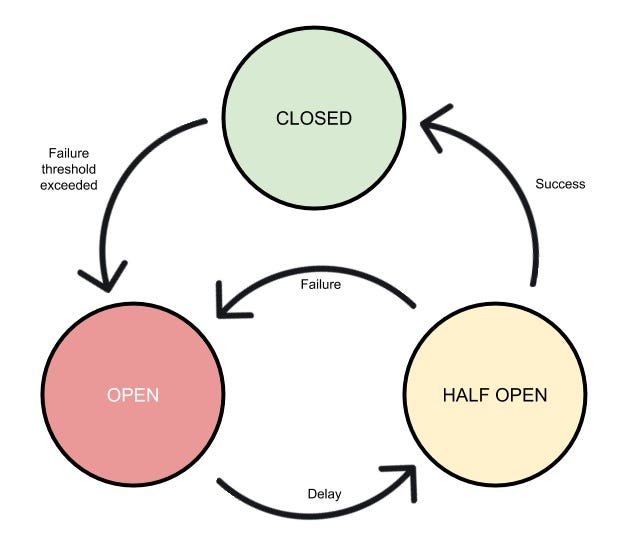The Circuit Breaker Pattern: Enhancing System Resilience
In the realm of software engineering, system resilience is paramount. As systems grow in complexity, the potential for failure multiplies, making robust error handling and failure management essential. This is where the Circuit Breaker pattern, a design pattern first popularized by Michael Nygard in his book "Release It!", comes into play.
Understanding the Circuit Breaker Pattern
The Circuit Breaker pattern is inspired by its namesake in electrical engineering: a circuit breaker that automatically cuts off electric flow when a fault is detected, preventing further damage. In software, the Circuit Breaker pattern prevents a network application or a service from performing an operation that's likely to fail. This pattern is particularly useful in microservices architectures where it's crucial to prevent a single service failure from cascading to other services.
How It Works
The Circuit Breaker pattern involves three key states:
Closed: In this default state, the circuit allows calls to the service. The failure count is monitored, and if failures reach a certain threshold, the circuit transitions to the open state.
Open: In this state, the circuit prevents calls to the service and immediately returns an error to the caller. This state allows the failing service time to recover. After a predetermined timeout, the circuit moves to the half-open state.
Half-Open: Here, the circuit allows a limited number of test calls to pass through to the service. If these calls succeed, the circuit returns to the closed state; if not, it reverts to open.
Benefits of the Circuit Breaker Pattern
Failure Protection: It prevents a client from waiting needlessly for a response from a service that's likely to fail.
Service Recovery Time: By opening the circuit, the pattern allows a struggling service time to recover, reducing the chance of a system-wide failure.
System Stability: It enhances overall system stability by preventing cascading failures in interconnected services.
Real-time Feedback: Implementing circuit breakers provides real-time feedback on the health of services, aiding in monitoring and alerting.
Implementing the Circuit Breaker Pattern
Various libraries and frameworks support the Circuit Breaker pattern. For instance, Netflix's Hystrix, Resilience4j for Java, and Polly for .NET are popular choices. When implementing, it's crucial to configure:
The failure threshold to open the circuit.
The timeout for the open state.
The number of test requests in the half-open state.
The type of failures that should trip the circuit.
1. Define the Circuit Breaker States
In Go, you can define a custom type to represent the state of the circuit breaker:
type State int
const (
Closed State = iota
Open
HalfOpen
)
type CircuitBreaker struct {
state State
failureCount int
failureThreshold int
halfOpenSuccessCount int
halfOpenSuccessThreshold int
resetTimeout time.Duration
lastFailureTime time.Time
// Add other necessary fields like a mutex for thread safety
}
2. Implement State Transitions
You'll need to implement logic to transition between states:
Closed to Open: Triggered when the failure count exceeds a predefined threshold.
Open to Half-Open: Triggered after a certain timeout.
Half-Open to Closed/Open: Depending on the success or failure of test calls.
3. Handling Requests
Create a method that handles requests through the circuit breaker. This method should:
In the Closed state, allow operations and track failures.
In the Open state, immediately return an error or a fallback response.
In the Half-Open state, allow a limited number of test calls and monitor their success or failure.
Example method skeleton:
func (cb *CircuitBreaker) Execute(action func() error) error {
switch cb.state {
case Closed:
return cb.executeClosed(action)
case Open:
return cb.executeOpen(action)
case HalfOpen:
return cb.executeHalfOpen(action)
}
return fmt.Errorf("invalid circuit breaker state")
}
4. Implementing Thread Safety
Since Go is a concurrent language, it's important to ensure that your circuit breaker is thread-safe. You can use mutexes to protect shared data in the CircuitBreaker struct.
5. Testing the Circuit Breaker
Testing is a crucial part of implementing the Circuit Breaker pattern. Write unit tests to ensure your circuit breaker behaves correctly in different scenarios:
Simulate failures to trigger state transitions.
Ensure that the reset timeout works as expected.
Verify that the circuit breaker handles concurrent requests correctly.
6. Integration and Configuration
Integrate the circuit breaker into your application. This involves wrapping calls to external services or potentially failing operations with your circuit breaker logic. Also, configure the threshold values, timeouts, and other parameters according to your specific use case.
7. Monitoring and Logging
Add monitoring and logging to your circuit breaker to observe its behavior in a production environment. This can help in fine-tuning the thresholds and timeouts.
Example Circuit Breaker Implementation
Here is a basic example of how a simple circuit breaker might be implemented in Go:
// Define the CircuitBreaker struct and methods here
func main() {
cb := NewCircuitBreaker(5, 10*time.Second, 2) // Example configuration
for i := 0; i < 100; i++ {
err := cb.Execute(func() error {
// Replace with actual call to an external service
return mockExternalServiceCall()
})
if err != nil {
fmt.Println("Request failed:", err)
}
time.Sleep(1 * time.Second)
}
}
func mockExternalServiceCall() error {
// Simulate a service call which may succeed or fail
return nil // or an error
}
Challenges and Considerations
While the Circuit Breaker pattern is powerful, it's not a silver bullet. It adds complexity to the system, and improper configuration can lead to issues like false positives (tripping the circuit unnecessarily) or false negatives (not tripping when it should). Therefore, understanding the specific needs of your system and thorough testing are essential for effective implementation.
The Circuit Breaker pattern is a vital component in the toolbox of modern software architects and developers. By intelligently managing failures, it enhances the resilience and stability of applications, especially in distributed systems like microservices. As with any pattern, careful consideration and customization are key to its successful adoption.
